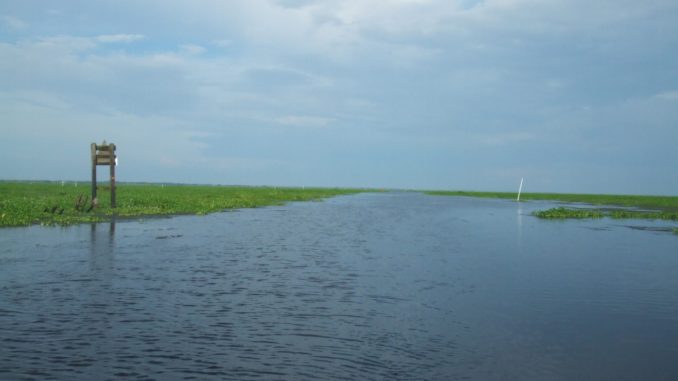
LOUISIANA: A Sportsman’s Paradise
Red fish are in the local lakes and the passes. Speckle trout are piled-up along the coast and schooling up over the inland reefs. Bass, bream and sac-au-lait are active as the summer time winds down. If you are a sport fan, then the 2008 Beijing Olympics have probably captivated most of your attention.
Combine the Olympics with the opening of the school and high school football, and we forget that hunting season is upon us.
The first of three splits of dove season opens and teal season opens – which means that fishing will take a back seat to hunting for a while.
Before you walk out into the dove field or hook-up the boat to go teal hunting, here is some helpful information.
Commission sets migratory bird seasons
The Louisiana Wildlife and Fisheries Commission set the tentative dates for early migratory bird hunting.
A population estimate below 4.7 million would provide a nine-day season and an estimate above that base line provides for a 16-day season.
The 2008 estimate was over 6 million, allowing for a proposed teal season of 16 days from Sept. 13 to 28.
A daily bag limit of four and possession limit of eight will be allowed.
North and south dove zones
The proposed dove season is broken down into a north and south zone with each zone having three segments and includes mourning, white-winged, Eurasian collared and ringed-turtle doves.
The dove season in the south zone will go from Sept. 6 to 14, Oct. 18 to Nov. 30 and Dec. 20 to Jan. 5.
The north zone will be from Sept. 6 to 21, Oct. 11 to Nov. 9 and Dec. 13 to Jan. 5.
The daily bag limit for mourning, white-winged and fully dressed Eurasian collared-doves and ringed-turtle doves will be 15 in aggregate and possession of 30 in aggregate.
However, there is no bag limit on Eurasian collared-doves or ringed turtle-doves provided that a fully feathered wing and head remain attached to the carcass of the bird.
Fully dressed Eurasian-collared doves and ringed turtle-doves (those without a fully feathered wing and head naturally attached to the carcass) shall be included in the aggregate bag.
For a complete listing of dove and waterfowl season boundary lines, and public hunting opportunities and leases, visit www.wlf.state.la.us.
Hunting license rules and regulations
Annual hunting and fishing licenses go on sale June 1 each year and expire June 30 of the following year.
Recreational fishing and hunting licenses may be purchased online or by telephone using Visa or Master Card. Call toll free 1-888-765-2602.
An authorization number for immediate use will be provided and licenses will be mailed to the licensee.
Everyone born on or after Sept.r 1, 1969, must show proof of satisfactorily completing a hunter safety course approved by LDWF to purchase a basic hunting license, except any active or veteran member of the United States armed services or any post-certified law enforcement officer.
Application for the exemption should be filed in person at the Department of Wildlife and Fisheries main office building in the city of Baton Rouge.
Licensed hunters hunting migratory game birds (mouring doves, ducks, geese, woodcock, rails snipe, coots, or gallinules) in Louisiana must be HIP – Harvest Information Program – certified in addition to their appropriate licenses. This is a short survey free of charge.
Anyone who hunts on any land administered by the Department including Wildlife Refuges and Wildlife Management and Habitat Conservation Areas must have a valid WMA hunting permit – ages 18 to 59. That permit is a $15 charge.
License information for teal hunters
Any resident waterfowl hunter, age 16 to 59, must carry a valid Louisiana duck license ($5.50), a federal duck stamp ($15) signed in ink across the face, and a Louisiana HIP permit (obtained free).
The hunter?must also carry a basic hunting license.
If on a Wildlife Management Area you must posses a WMA hunting permit and a self-clearing permit.
Fish still biting in local waters
With the approach of dove hunting and the tradition of teal hunting, the passion to pick-up a rod-n-reel is always there.
Recent trips to Seabrook produced limits of quality puppy drum and few speckle trout. Lake Cataouatche still is producing good catches of bass and bream.
The bass like the Ribbit in melon and red and pearl, white spinner baits and shad colored crank baits.
The bream have been hitting crickets and earthworms. Fly rods and popping bugs have worked extremely well, any color popping bug.
The grass and lilies have taken over the entire north and western side of the lake.
Make sure to stay in the traveled boating lanes. Be careful getting to your favorite spots.
The water conditions are clear from Lake Des Allemands to Lake Salvador. A good report of a catch of sac-au-lait came from the Gulf Canal in the Salvador Management Area.
The red, white and chartreuse jig worked the best fishing the middle of the canal around the grass beds.
Lake Salvador to Little Lake has red fish gobbling up gold spoon and black and chartreuse beetles with a gold spinner.
Shrimp on a jig head will catch reds and sheepheads.
Captain Tommy Lanata said it best, ” What a great state to live in!”
“Fish in the morning and hunt in the afternoon.”




Be the first to comment